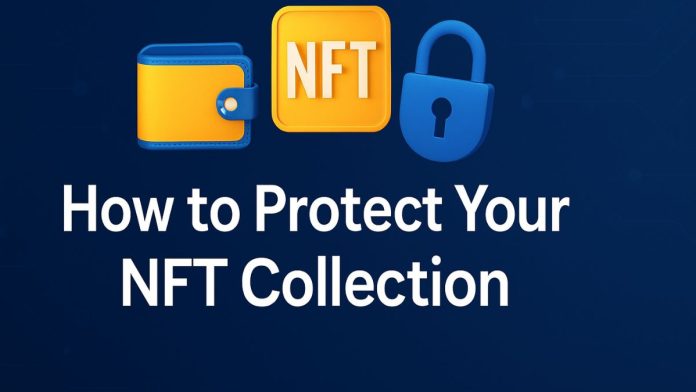Non-fungible tokens (NFTs) have revolutionized digital ownership, offering new opportunities for creators, collectors, and investors. From artwork to music, virtual land, and gaming assets, NFTs represent unique digital items stored on the blockchain. However, the rapid growth of this space has also attracted malicious actors, making it vital for NFT holders to take proactive steps to protect their digital assets.
This guide outlines how to protect your NFT collection, covering best practices for wallet security, phishing prevention, storage solutions, and recovery measures. Whether you’re new to NFTs or a seasoned collector, these tips will help you secure your investments.
Understanding NFT Vulnerabilities
Before diving into protection methods, it’s important to understand the main risks NFT owners face:
Phishing Attacks: Phishing attacks trick users into giving up private keys or signing malicious transactions. These scams often mimic trusted platforms or use fake social media profiles.
Malware and Keyloggers: Hackers can install malware on your device to monitor keystrokes and gain access to your wallet.
Fake Marketplaces and Contracts: Some attackers create counterfeit marketplaces or smart contracts that exploit users when they interact with them.
Insider Threats: If you’re part of a team or share your collection across wallets, other individuals with access may pose a risk.
Lost Access: Losing access to your private keys, seed phrases, or hardware wallet can result in permanent loss of your NFTs.
How to Safeguard Your NFT Collection?
Lets check out top methods to protect your NFT wallet:
1. Use a Hardware Wallet
A hardware wallet is one of the most secure ways to store NFTs because it keeps your private keys offline, making them nearly impossible to hack remotely. Devices like the Ledger Nano or Trezor allow you to sign transactions without ever exposing your key to the internet. When storing your NFT collection, using a hardware wallet prevents malware, phishing, and browser-based attacks from compromising your assets.
Even if your computer is infected or your internet is intercepted, the hardware wallet acts as a secure layer of protection. You’ll still need to set a strong PIN and store your recovery phrase securely, as losing access to either can result in permanent loss. However, the device itself is tamper-resistant and designed to withstand most attempts at forced access.
Many NFT platforms support hardware wallets directly, making it convenient to view or list NFTs without sacrificing safety. It’s especially ideal for high-value collections or long-term holders who don’t need to interact frequently with marketplaces. Using a hardware wallet also provides peace of mind, knowing that even if someone compromises your browser or social media accounts, they can’t move your assets without physically accessing your wallet and confirming the transaction on the device screen.
Popular Hardware Wallets:
- Ledger Nano X/S Plus
- Trezor Model T
- GridPlus Lattice1
Advantages:
- Private keys never leave the device
- Immune to online hacks
- Ideal for long-term holding
Tips:
- Always buy directly from the manufacturer
- Store your device in a secure place
- Use a strong PIN and recovery phrase
2. Secure Your Seed Phrase
The seed phrase is the single most important element in accessing and recovering your NFT wallet. This string of 12 to 24 random words acts as the master key to your entire collection. If someone else gains access to it, they can restore your wallet and transfer all your NFTs without your permission. Storing this phrase properly is crucial. It should never be saved digitally—no screenshots, cloud backups, or plain text files. Writing it down on paper and storing it in a secure, offline location such as a safe is the simplest method.
For added protection, many collectors opt to engrave it on metal plates that are fire and water-resistant. Advanced users may use multi-location backups or apply secret-sharing techniques to split the phrase into parts. The goal is to ensure you can always recover your wallet while preventing anyone else from doing so. It’s also wise to consider who can access the phrase in case something happens to you—whether it’s a family member or legal representative, there should be a trusted backup plan. Without secure storage and a proper inheritance plan, your NFT collection could be permanently lost or easily stolen.
Best Practices:
- Never share it online or via email
- Write it on paper or engrave it on a metal plate (fire/water resistant)
- Store it in a safe or bank deposit box
- Consider using a split backup (shamir’s secret sharing)
What NOT to Do:
- Don’t take screenshots or store it in cloud storage
- Don’t keep it on your phone or computer in plain text
3. Avoid Phishing and Scams
Phishing is one of the most common ways NFTs are stolen, often through deceptive websites, fake social media accounts, or messages that prompt users to sign malicious transactions. Scammers frequently mimic legitimate platforms like OpenSea or MetaMask, directing victims to fake login portals or urging them to verify their wallet for rewards or airdrops. Once a user connects their wallet and approves a transaction, attackers can drain NFTs instantly.
To defend against phishing, vigilance is key. Always verify URLs, avoid clicking on unverified links, and bookmark official platforms. Be especially cautious in Discord and Telegram groups, where impersonators frequently post malicious links. Turn off DMs in Discord or adjust settings so only friends can message you. Never share your seed phrase with anyone, even if the message appears official. Confirm announcements through multiple trusted sources before participating in mints or giveaways.
Using browser extensions that alert you to suspicious domains can also be helpful. Recognizing the signs of a scam and resisting impulsive clicks is your best defense. Once an NFT is stolen through a phishing attack, there’s often no way to recover it, so proactive caution is essential for long-term safety in the NFT ecosystem.
4. Use Burner Wallets for Risky Transactions
A burner wallet is a temporary or low-value wallet used for interacting with unknown or untrusted platforms. This method limits risk by separating your main NFT collection from potentially dangerous transactions such as free mints, early-stage projects, or airdrops. Since malicious smart contracts can gain permissions to your wallet, using a burner wallet ensures that even if something goes wrong, your core holdings remain untouched.
You simply create a new wallet, fund it with a small amount of ETH or another token, and connect only when necessary. If the interaction is safe and the NFT proves valuable, you can later transfer it to your main wallet for storage. This practice isolates risk and adds a security buffer between experimental interactions and your long-term collection. It also helps in managing gas fees, transaction clutter, and token approvals more efficiently.
Keeping this separation clear prevents unintentional approvals or compromises. Many experienced users rotate burner wallets regularly and maintain a strict policy of never connecting their primary wallet to unknown sites. It’s a simple but highly effective strategy, especially as Web3 continues to evolve with both innovation and increasing threats. Treating your main wallet like a vault and your burner like a sandbox can significantly reduce your exposure to scams.
5. Revoke Smart Contract Approvals
Every time you interact with a decentralized application or NFT marketplace, you often grant that platform permission to move or manage tokens on your behalf. These permissions, known as token approvals, remain active even after the interaction ends. Malicious actors can exploit these dormant permissions to drain assets if the platform or contract becomes compromised. That’s why it’s important to regularly audit and revoke unnecessary approvals.
You can use blockchain tools such as Etherscan’s token approval checker or services like Revoke.cash to view a list of all granted permissions from your wallet. Revoking these permissions costs a small gas fee but greatly reduces your risk of unauthorized access. For example, if you minted an NFT from a project months ago and haven’t interacted with it since, there’s no reason to keep that approval active.
Even some well-known projects have been exploited through compromised smart contracts, catching collectors off guard. Revoking is a preventative measure, like locking doors you no longer use. Set a regular schedule—monthly or after major drops—to clean up old approvals and maintain a minimalist, secure wallet profile. It’s a habit that can save you from future loss, especially when navigating the unpredictable and evolving world of NFTs.
Frequently Asked Questions (FAQs)
What’s the safest way to store my NFTs?
The safest method is using a hardware wallet (cold wallet), which stores your private keys offline. This makes it virtually immune to online attacks like phishing, malware, or hacking attempts.
Can my NFTs be hacked?
NFTs themselves can’t be hacked, but your wallet can be compromised if you expose your private key or approve a malicious contract. Hackers exploit user mistakes, not the blockchain.
What is a burner wallet and why should I use one?
A burner wallet is a temporary wallet used for risky interactions, such as claiming free airdrops or minting NFTs from unknown sources. It isolates your main wallet from potential threats.
What happens if I lose my seed phrase?
If you lose your seed phrase, you lose access to your wallet and NFTs permanently. There is no recovery option without it, so store it offline and securely.
Final Thoughts
Protecting your NFT collection isn’t just a one-time task—it’s an ongoing responsibility. The decentralized nature of NFTs means you are your own bank, and with that power comes the burden of security. Unlike traditional banking systems, there’s no customer service to call if your assets are stolen or lost.
By combining best practices in wallet security, scam prevention, legal preparedness, and education, you can build a robust defense for your digital collectibles. Whether your NFTs are worth a few dollars or millions, treating them with care ensures that they remain safe for years to come.

![How to Play Bing Homepage Quiz? [2025 Updated] how-to-play-bing-homepage-quiz](https://www.internetoutsider.com/wp-content/uploads/2025/05/how-to-play-bing-homepage-quiz-218x150.jpg)

![How to Use WhatsApp Web? [Beginners Friendly] how-to-use-whatsapp-web-thumb](https://www.internetoutsider.com/wp-content/uploads/2025/05/how-to-use-whatsapp-web-thumb-218x150.jpg)



